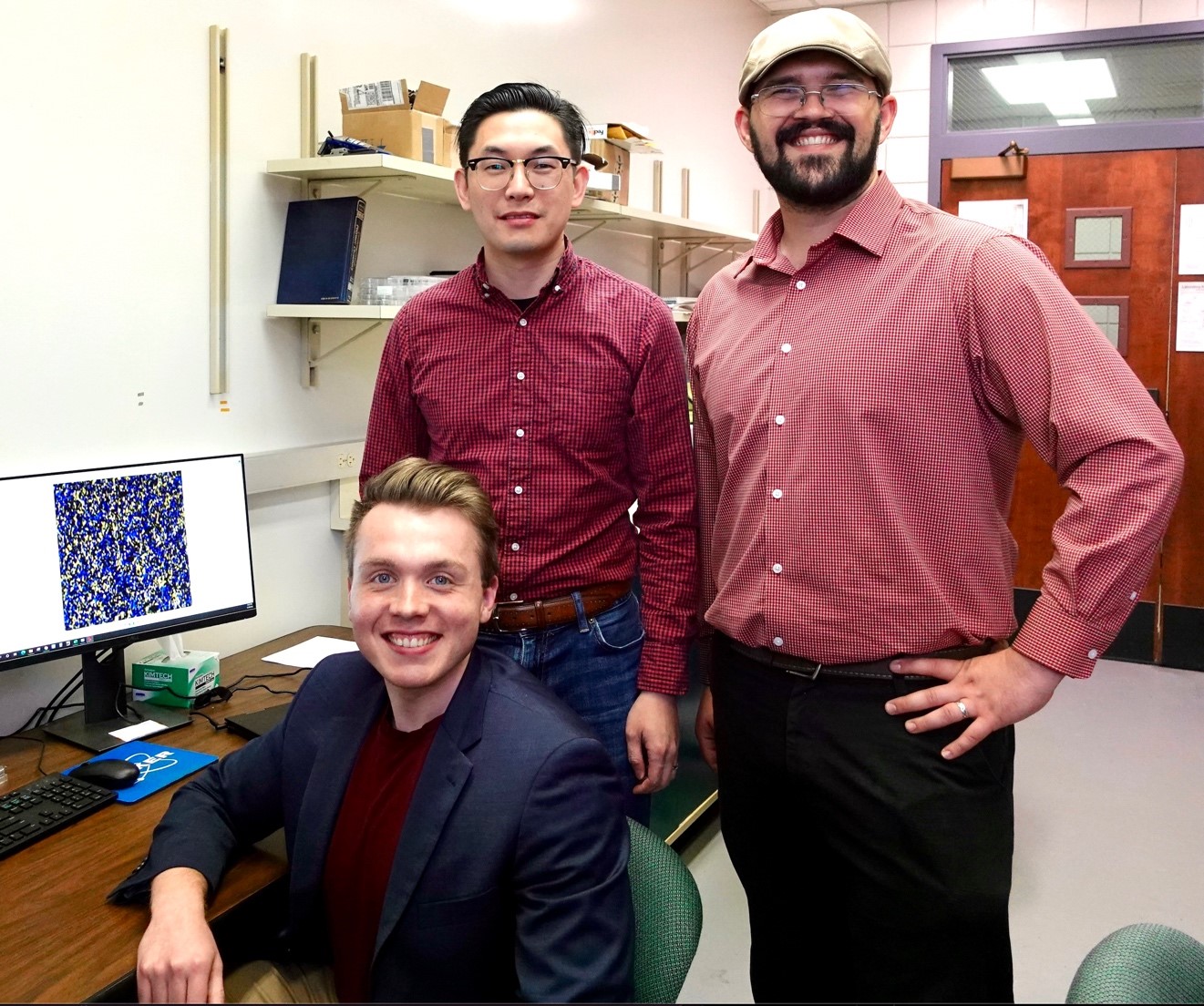USM Polymer Graduate Students’ Research Highlighted in Prestigious Journal
Mon, 04/11/2022 - 02:46pm | By: Van Arnold

Pictured left to right: Nathaniel Prine (seated), Dr. Xiaodan Gu, and Luke Galuska.
The collaborative research efforts on stretchable polymer LEDs by University of Southern Mississippi (USM) graduate student Nathaniel Prine and recent doctoral graduate Luke Galuska have led to a highlighted piece in the prestigious science journal Nature.
The paper is officially titled: "High-brightness all-polymer stretchable LED with charge-trapping dilution." In this work, a OLED display, which is commonly used in modern cell phones, was demonstrated as stretchable displays.
Prine, a fourth-year doctoral student, works in a research group led by USM polymer Professor Xiaodan Gu. Galuska recent defended his Ph.D dissertation in polymer science and engineering within the Gu group.
A native of Hattiesburg, Miss., Prine says the recognition by Nature is both humbling and gratifying.
“I am excited to have our collaborative efforts recognized in such a prestigious journal. Even though my contribution was one of many others, I was honored to work with high-impact scholars who are trailblazing new pathways in science that future generations will follow,” said Prine.
Prine points out that the fundamental significance of the collaborative research is that the team developed a material design strategy and fabrication process to create extremely bright and stretchable LEDs.
“Not only does this project help us better understand the intrinsic properties of novel conjugated polymers, but it also opens up potentially new, practical applications for organic electronics such as electronic skin and other bioelectronic applications,” he said.
Galuska, a native of Houston, Texas, added: “It is an honor to be a part of this great collaborative work. The development of soft and stretchable light-emitting displays with high brightness is a great achievement for the scientific community which is evident by the acceptance of this work into the prestigious journal Nature.”
As his contribution to the project, Prine used atomic-force microscopy paired with infrared spectroscopy (AFM-IR) to study the interactions and morphology of the stretchable LED material. AFM-IR is one of the most effective techniques for simultaneously mapping the topography and chemical composition of material surfaces. The AFM-IR technique entails dragging or tapping a needle-like probe across the sample surface while simultaneously irradiating the sample with a pulsed, tunable infrared laser.
“One can think of it as a microscope that ‘touches’ to interpret the sample surface much like a person uses their finger to read Braille,” he said. “The infrared light can be tuned to excite specific molecular bonds to distinguish multiple materials in a complex blend. When the targeted material is excited, it thermally expands and displaces the probe by a few picometers in height. Using this technique, we can create a chemical map of material surfaces and observe features as small as 10 nanometers.”
This AFM-IR technique was specifically used in this project to understand how the light-emitting polymer, “Super Yellow”, and a stretchable polyurethane behaved when they were processed together. The project was in collaboration with the research group led by Dr. Zhen an Bao, an accomplished professor of chemical engineering located at Stanford University.
“Our group specializes in the mechanical and morphological performance of thin film semiconducting polymers and have had several great collaborations with the Bao research group,” noted Galuska. “In this work, I assessed the mechanical performance of these polymers using our pseudo-freestanding film on water tensile technique. This allowed us to quantify the stiffness of the materials, as well as their ductility, as a function of the concentration of the light-emitting polymer. Not only were these materials soft but highly stretchable, which is unique in comparison to traditional inorganic devices.”
Gu said he was thrilled to hear about the contributions his students made that led to publication in the highly acclaimed science journal.
“It is extremely rare for a scientist at the University of Southern Mississippi to publish in the top scientific journal Nature. I do not recall we had anyone do that in the past 10 years,” said Gu. “The recent investment from the university in research and development is very critical for this. This is a great testimony to our university’s commitment to being a highly research-active R01 university.
Added Gu: “The recent investments from the University and EPSCOR research grant greatly helped Mississippi to boost its research infrastructure. Without that support, it is impossible for the faculty to attract and retain talented graduate students and help them to collaborate and compete on the national stage. I am also grateful for many research opportunities that my collaborators provided, particularly Professor Zhen an Bao, who is a world leader in skin-inspired electronics, at Stanford University to work with us on this exciting project.”
This work is led by Stanford University, and other co-authors from the Lawrence Berkeley National Laboratory.
The article can be accessed at Nature Publishing Group: https://www.nature.com/articles/s41586-022-04400-1